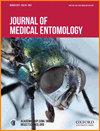评估发光二极管在巴西亚马逊河流域城市公园中的噬线虫(双翅目:灵虫科)采样效果
IF 2
3区 农林科学
Q1 ENTOMOLOGY
引用次数: 0
摘要
罗德里格斯-阿尔维斯公园(Bosque Rodrigues Alves)是巴西亚马逊贝伦市区周围的一个森林公园,本研究旨在评估不同光源对该公园中的噬线虫(双翅目:Psychodidae)进行采样的效果。试验组使用了美国疾病控制中心的诱捕器,诱饵为蓝色、绿色和暖白色发光二极管(LED),对照组使用白炽灯。对光源的电磁波谱和发光强度进行了表征。还估算了每个采样点的植被覆盖率。估算并比较了丰度、富集度、稀疏度曲线、香农和辛普森多样性指数、血吸虫/诱捕器/小时和血吸虫/诱捕器/夜。试验组的光源比对照组的光源更强,但彼此相似。每个地点的植被覆盖率没有差异。共采样了 11 个物种的 1 346 只海蛞蝓。数量最多的物种如下Nyssomyia antunesi(Coutinho,1939 年)、Trichophoromyia ubiquitalis(Mangabeira,1942 年)、Bichromomyia flaviscutellata(Mangabeira,1942 年)和 Th. brachipyga(Mangabeira,1942 年)。使用 LED 的灯光诱捕器的丰富度、丰度和香农多样性指数与使用白炽灯的诱捕器相似。暖白色 LED 的辛普森指数高于其他光源。在大多数分析中,蚜虫对白炽灯的反应与对 LED 的反应相似,这证实了这些光源作为昆虫监测替代设备的适用性。低消耗确保了诱捕器更大的自主性,为野外工作提供了更好的可操作性。本文章由计算机程序翻译,如有差异,请以英文原文为准。
Assessment of light-emitting diodes for sampling phlebotomines (Diptera: Psychodidae) from an urban park of the Brazilian Amazon
The present study aimed to assess different light sources for sampling phlebotomines (Diptera: Psychodidae) from Bosque Rodrigues Alves, a forested park surrounded by the urban area of Belém in the Brazilian Amazon. Centers for Disease Control traps, baited with blue, green, and warm white light-emitting diodes (LEDs), as test group, and incandescent light, as control group, were used. The electromagnetic spectra and luminous intensities of the light sources were characterized. Fractional vegetation cover at each sampling site was also estimated. Abundance, richness, rarefaction curves, Shannon and Simpson diversity indices, phlebotomines/trap/hour, and phlebotomines/trap/night were estimated and compared. The light sources of the test group presented greater luminous intensity than the control, but were similar to each other. There were no differences in vegetation cover at each site. A total of 1,346 phlebotomines comprising 11 species were sampled. The most abundant species were as follows: Nyssomyia antunesi (Coutinho, 1939), Trichophoromyia ubiquitalis (Mangabeira, 1942), Bichromomyia flaviscutellata (Mangabeira, 1942), and Th. brachipyga (Mangabeira, 1942). Light traps with LEDs had richness, abundance, and Shannon diversity indices similar to those obtained with incandescent light. The warm white LED had a higher Simpson’s index than the other light sources. Phlebotomine responses to incandescent light were similar to those to LEDs in most analyses, confirming the applicability of these light sources as alternative devices for entomological surveillance. Low consumption ensures greater autonomy of the traps, providing better operability during fieldwork.
求助全文
通过发布文献求助,成功后即可免费获取论文全文。
去求助
来源期刊
CiteScore
4.60
自引率
14.30%
发文量
207
审稿时长
3-8 weeks
期刊介绍:
Journal of Medical Entomology is published bimonthly in January, March, May, July, September, and November. The journal publishes reports on all phases of medical entomology and medical acarology, including the systematics and biology of insects, acarines, and other arthropods of public health and veterinary significance. In addition to full-length research articles, the journal publishes Reviews, interpretive articles in a Forum section, Short Communications, and Letters to the Editor.

 求助内容:
求助内容: 应助结果提醒方式:
应助结果提醒方式:


